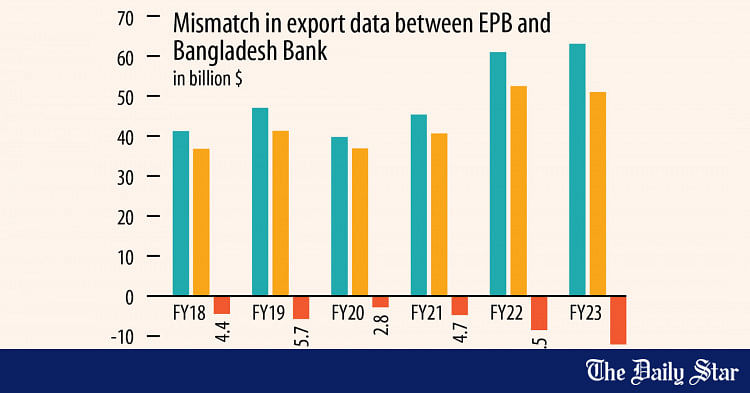You can lie with data or illuminate the truth with data. And there’s something in between — half-truths.
A $14 billion correction in export figures by the central bank is necessary because it addresses an economic half-truth.
But half-truths are disturbing.
The revision of data that came on Wednesday through a regular balance of payments update raises worrisome questions about the country’s economic performance and the politics revolving around it.
The shocking revelation has economists scrambling for answers, but there are more questions than answers as the authorities are almost silent.
What is clear is that the discrepancy in export figures underscores again the importance of accurate macroeconomic data. Lack of statistical precision can spoil many indicators. Calculating gross domestic product is one of them.
Such a large discrepancy is “unbelievable”, said MK Mujeri, an economist and former director general of the Bangladesh Institute of Development Studies.
Calculating export and import data is a simple task, but gross errors like this by officials raise questions about the veracity of other components of the economy. “All estimates of GDP must be revised”, Mujeri said.
His position is consistent with the views expressed by other economists.
“If the ratio of this discrepancy has increased significantly over time, then this should call for a revision of growth estimates,” said Ashikur Rahman, chief economist at the Bangladesh Policy Research Institute.
With the discovery, several other issues came to the fore.
The statistical review suggests that the Bangladesh Bank and the finance ministry have finally admitted that no significant export earnings are being held abroad, as exporters have claimed for years. This means that the trade deficit is much larger than originally assumed. This also shows that the target of reaching $110 billion in exports by 2027 is far from reality.
“In other words, we now need to formulate a more realistic export strategy and identify which exact constraints are hampering our export performance,” Ashikur said.
The gap between export figures calculated by the Export Promotion Bureau and Bangladesh Bank has persisted for at least 12 years, with the gap crossing $12 billion in fiscal 2022-2023.
Economists have long referred to the conundrum. Finally, the central bank woke up and reconciled the discrepancy for the July-April period of the 2023-24 fiscal period. As a result, exports fell 6.8 percent during the period, a sharp contrast to the 3.93 percent increase shown in EPB figures released earlier.
Moreover, Bangladesh risks damaging its reputation abroad. The country’s image as a garment powerhouse defined by sheer volume of shipments will be seriously damaged. Apparel exports, which account for about 10 percent of the economy, are an important indicator that sets the country apart from its peers.
SOME REVIEWS ARE NOW OUT OF DATE
It will create serious data chaos. Whatever Bangladesh has valued in the past has now become “largely irrelevant,” said Fahmida Khatun, executive director of the Center for Policy Dialogue.
EPB publishes figures based on data from the customs department. Apparently, for procedural reasons or otherwise, the customs department has considered the same export data more than once in many cases, known as double or triple counting.
According to EPB data, exports were $47.47 billion in the July-April period of 2023-2024. However, the amount was $33.67 billion after the correction, according to data released by the central bank on Wednesday.
But it is not clear how long such incorrect data entry has been going on.
A good policy framework depends on authentic data. Poor quality data give wrong signals to policy makers.
“If policy-making is based on unreliable data, then policies become irrelevant and don’t work,” said Fahmida. Unfortunately, citizens have been misled about the real economic situation due to such anomalies perpetuated by government organizations, she said.
These errors indicate the extent of data governance or lack thereof in Bangladesh. Without quality information, making informed policies is difficult, said MA Razzaque, chair of Research and Policy Integration for Development.
The discrepancy in export data will have an impact on GDP estimates because the value added by exports is included in the GDP calculation. The ratio of added value is about 60 percent. So the GDP impact will be up to $6 billion, Razzaque said.
Md Deen Islam, associate professor of economics at Dhaka University, said this correction would lower the GDP growth rate, with exports contributing less to overall economic output, GDP growth rates for the period future forecasts for economic growth will have to be revised downwards. will need to be adjusted to reflect more accurate export figures, potentially leading to more conservative growth estimates.
The landmark review could create temporary confusion and mistrust among stakeholders, including businesses, investors and international partners, he said.
“Reviews may lead to questions about the credibility and reliability of economic data published by national agencies,” he added.
Deen Islam said policymakers may need to reassess their strategies to stimulate economic growth and stabilize the macroeconomic environment as revised export figures show a significant decline.
However, the reconciliation of export data provides a more accurate picture of Bangladesh’s economic landscape, which is crucial for effective policy-making and strategic planning, Deen Islam said.
Birupaksha Paul, an economics professor at the State University of New York, said it was a positive move towards proper balance of payments accounting.
A senior EPB official said it does not produce export data. The agency compiles export data based on numbers it receives from the customs wing of the National Board of Revenue and the central bank.
“We see the export data only after the goods are shipped. If any cargo is returned, EPB has no way of detecting this,” he said, adding that it is monitored by the WB and the NBR.
“However, if we need to correct any data, we will,” said the official. There is a commission made up of representatives from EPB, BB, NBR and other agencies.
EPB has yet to release data for July-June FY24, although it usually releases figures at the beginning of each month.
Saiful Islam, executive director of Bangladesh Bank, said that henceforth, the central bank will base the calculation on corrected export data.
Asked about the previous data discrepancy between the WB and EPB, he said there was no problem with the past data. There was a problem with the reporting method. He did not give details.
Despite the major recovery, the health of the economy remains unchanged. The correction addresses anomalies but does not fundamentally change the economic landscape.
[Refayet Ullah Mirdha and Md Mehedi Hasan contributed to this report]
Image Source : www.thedailystar.net







Leave a Reply